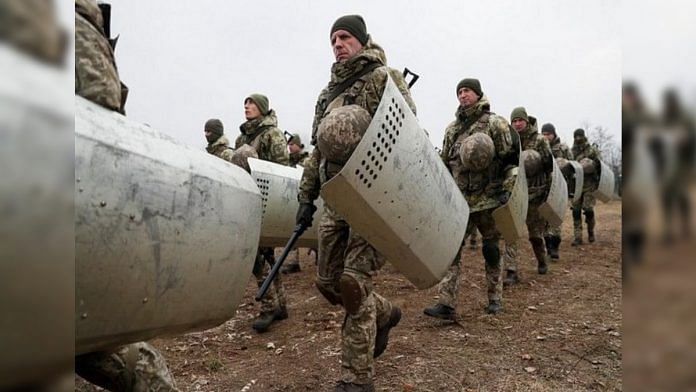New Delhi: As Russian forces bombarded cities including Kyiv and Kharkiv Thursday, and tanks rolled across the border for a full-scale invasion of Ukraine — an unprecedented escalation from the long-simmering conflict in the eastern provinces — the situation on the ground brought to the fore the stark imbalance of military power between the two countries, while Russian President Vladimir Putin warned the West against interfering.
According to the annually updated warfare capacity index Global Firepower, Russia’s active manpower outnumbers Ukraine’s by a factor of more than four times — 8,50,000 compared to 2,00,000 — and its defence budget outstrips Ukraine’s 13 times over — $154 billion compared to $11.87 billion.
In terms of equipment, Russia has 4,173 aircraft in its fleet to Ukraine’s 318, 30,122 armoured vehicles to Ukraine’s 12,303, and 605 warships to Ukraine’s 38.
But the key imbalance evident from Thursday’s bombings has been on the basis of missiles available on either side, another category in which Russia outdoes Ukraine by far.
Russia also maintains the world’s largest arsenal of nuclear weapons. Ukraine, meanwhile, has none remaining.
At the time of the overnight dissolution of the Soviet Union, Ukraine was left with a little less than 9,000 nuclear weapons, 176 intercontinental ballistic missiles, and 44 strategic bombers. But the country gave up its nuclear weapons and signed the Budapest Memorandum in 1994 based on assurances on border security, according to Washington-based think tank German Marshall Fund.
The missile gap
In a video Wednesday, Putin had reportedly warned that Russia has developed hypersonic missiles as part of its development of “advanced weapons systems”, and that they are ready to be fired at any moment.
In a “show of force” last week, Russia conducted nuclear drills using Kinzhal and Tsirkon hypersonic missiles, with Putin observing the launches alongside his Belarusian counterpart, Alexander Lukashenko.
While on-ground sources are yet to clarify what Russia has actually deployed against civilians in major cities such as Kyiv and Kharkiv, the UK-based think tank Royal United Services institute (RUSI) claimed in a 15 February report that Russia has “amassed a large arsenal of short-range ballistic missiles and cruise missiles”.
Furthermore, Foreign Policy had reported on 20 January that Russian forces were allegedly moving 9K720 Iskander-M missiles under tarpaulins towards the frontlines in eastern Ukraine. Russia had previously used Iskander missiles in Syria
Known as the SS-26 Stone in NATO parlance, the 9K720 Iskander-M is a short-range ballistic missile “designed for tactical strikes on small, high-value land targets” and the version used in Russian service has a range of 500km, according to Global Security.
However, Iskander batteries are capable of firing both ballistic and cruise missiles and, when used to their full potential, can specifically target military bases.
“But what makes this missile system particularly nerve-wracking in the context of an expanded invasion into Ukraine is its ability to evade missile defences. It can correct its course mid-flight and has decoys on board to spoof defensive batteries (though those features have yet to be shown off in combat),” Foreign Policy added.
Ukraine, meanwhile, still utilises 120km-range Tochka-U tactical ballistic missiles, whose technology and development dates back to the Soviet era and lacks the precision and adaptability of the Iskander, as it only lands within 95 metres, on average, of a specific target.
Rather, among the newest missile technology in Ukraine’s arsenal is the Navy’s R-360 Neptune cruise missile, which was developed by the Kyiv-based Luch Design Bureau and boasts a range of up to 300 km.
But RUSI predicts that it is Russia’s aerial advantages that will ultimately have “a decisive impact on the ground”.
“The enemy air threat will make it exceedingly difficult to reposition units quickly without coming under devastating attack. The result is that Ukrainian units will likely be forced into positional defences. Russian units, by contrast, without the threat of significant air attack, will be able to manoeuvre to bypass and defeat Ukrainian units in detail,” the report added.
(Edited by Rohan Manoj)
Also read: Ukraine says over 203 Russian attacks since morning, capital Kyiv under curfew



